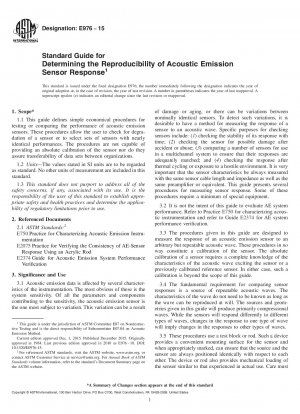ASTM E976-15
Standard Guide for Determining the Reproducibility of Acoustic Emission Sensor Response
- Standard No.
- ASTM E976-15
- Release Date
- 2015
- Published By
- American Society for Testing and Materials (ASTM)
- Status
- Replace By
- ASTM E976-15(2021)
- Latest
- ASTM E976-15(2021)
- Scope
3.1 Acoustic emission data is affected by several characteristics of the instrumentation. The most obvious of these is the system sensitivity. Of all the parameters and components contributing to the sensitivity, the acoustic emission sensor is the one most subject to variation. This variation can be a result of damage or aging, or there can be variations between nominally identical sensors. To detect such variations, it is desirable to have a method for measuring the response of a sensor to an acoustic wave. Specific purposes for checking sensors include: (1) checking the stability of its response with time; (2) checking the sensor for possible damage after accident or abuse; (3) comparing a number of sensors for use in a multichannel system to ensure that their responses are adequately matched; and (4) checking the response after thermal cycling or exposure to a hostile environment. It is very important that the sensor characteristics be always measured with the same sensor cable length and impedance as well as the same preamplifier or equivalent. This guide presents several procedures for measuring sensor response. Some of these procedures require a minimum of special equipment.
3.2 It is not the intent of this guide to evaluate AE system performance. Refer to Practice E750 for characterizing acoustic instrumentation and refer to Guide E2374 for AE system performance verification.
3.3 The procedures given in this guide are designed to measure the response of an acoustic emission sensor to an arbitrary but repeatable acoustic wave. These procedures in no way constitute a calibration of the sensor. The absolute calibration of a sensor requires a complete knowledge of the characteristics of the acoustic wave exciting the sensor or a previously calibrated reference sensor. In either case, such a calibration is beyond the scope of this guide.
3.4 The fundamental requirement for comparing sensor responses is a source of repeatable acoustic waves. The characteristics of the wave do not need to be known as long as the wave can be reproduced at will. The sources and geometries given in this guide will produce primarily compressional waves. While the sensors will respond differently to different types of waves, changes in the response to one type of wave will imply changes in the responses to other types of waves.
3.5 These procedures use a test block or rod. Such a device provides a convenient mounting surface for the sensor and when appropriately marked, can ensure that the source and the sensor are always positioned identically with respect to each other. The device or rod also provides mechanical loading of the sensor similar to that experienced in actual use. Care must be taken when using these devices to minimize resonances so that the characteristics of the sensor are not masked by these resonances.
3.6 These procedures allow co......
ASTM E976-15 Referenced Document
- ASTM E2075 Standard Practice for Verifying the Consistency of AE-Sensor Response Using an Acrylic Rod
- ASTM E2374 Standard Guide for Acoustic Emission System Performance Verification
- ASTM E750 Standard Practice for Characterizing Acoustic Emission Instrumentation
ASTM E976-15 history
- 2021 ASTM E976-15(2021) Standard Guide for Determining the Reproducibility of Acoustic Emission Sensor Response
- 2015 ASTM E976-15 Standard Guide for Determining the Reproducibility of Acoustic Emission Sensor Response
- 2010 ASTM E976-10 Standard Guide for Determining the Reproducibility of Acoustic Emission Sensor Response
- 2005 ASTM E976-05 Standard Guide for Determining the Reproducibility of Acoustic Emission Sensor Response
- 2000 ASTM E976-00 Standard Guide for Determining the Reproducibility of Acoustic Emission Sensor Response

Copyright ©2024 All Rights Reserved